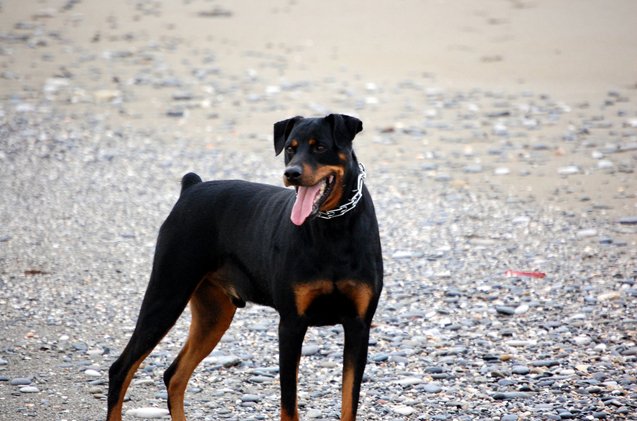Rotterman


About Rotterman
Also referred to as the Doberott, Rottie Dobie, Rottie Dobe, and Doberweiler, the Rotterman is a large and powerful dog that will require serious training. If you have the space and the time for one of these dogs, you’ll find that they are protective, loyal, and affectionate. But before you bring one home, keep reading to learn more about this breed and to determine if it’s your best match.
The Rotterman is a cross between a purebred Rottweiler and Doberman Pinscher.
The Rotterman is a designer dog breed from the United States.
The Rotterman is a cross between a purebred Rottweiler and Doberman Pinscher.
As with all other breeds, the Rotterman should be fed a canine-appropriate diet that will nourish his body and give him the energy he requires. Choose a brand of dog food that uses only the highest quality ingredients, and talk to your veterinarian if you have any questions regarding what, or how much, you should be feeding your pet.
To start, you could feed your dog 4-6 cups of a high quality dry food every day, but split this amount into at least two meals. If you wish to also provide your pet with a high quality canned food, just reduce the amount of dry food accordingly to give your dog the energy and nutrition he needs without causing overeating or unwanted weight gain.
Rotterman dogs can be trained to work with police and with the military.
You should expect that your Rotterman could exhibit an independent nature that makes him feel dominant, so firm but positive training will be required to establish yourself as the pack leader. Owners who are already experienced in dog training will do best with these pooches; otherwise, you may need to get help from a professional trainer.
These dogs can be trained to work with police and with the military, they excel at agility training and in search and rescue, and they also make good watchdogs and guard dogs. But, again, because they’re powerful and can have a dominant personality, you need to be serious about training your pet properly and establishing yourself as his leader.
If you have children or other pets, these canines can get along well with them, particularly when they’re properly trained and socialized.
A large to giant-sized breed, the Rotterman weighs between 70 and 130 pounds.
Rottermans are smart dogs that aren’t aggressive, despite their powerful, large body. In fact, they’ll prefer being the center of attention and activity in your home, and they’ll be gentle and even want to cuddle. However, these dogs can become harsh if they feel that they need to protect you or take care of themselves. First, though, they’ll calmly assess a new situation or a stranger.
Overall, Rottermans can be described as friendly, loving, loyal, and calm. They could become quite attached to their family, so you might even find your dog following you around the house just to be near you. Even though Rottermans could cope with a bit of time spent alone, they do prefer being around their family, so they shouldn’t be left home alone for extended periods of time.
Like all other hybrid canine breeds, the Rotterman could be susceptible to developing the health problems that most often affect its parent breeds. However, there’s no way to predict an individual dog’s long-term health, and there’s no guarantee that your dog will acquire any of these ailments. The best that you can do is be aware of the risks and, if symptoms develop, take your pet to the vet right away.
Rottermans may be prone to developing cancer, including bone cancer, hypothyroidism, bloat, heart issues, Von Willebrand’s disease, Wobbler syndrome, eye issues, allergies, joint dysplasia, albinism, color mutant alopecia, panosteitis, and narcolepsy.
The Rotterman has an average lifespan of 9 to 12 years.
A Rotterman requires a good amount of physical activity and exercise every day because this is an active breed. Owners who are active and who don’t mind taking their dog on outdoor adventures will enjoy the company of a Rotterman.
These dogs do best in homes with yards, as they’re large and will require plenty of space to feel comfortable. An enclosed backyard is a great place where your dog can run and enjoy interactive play sessions with you, but you should also provide him with a variety of toys indoors to keep him mentally stimulated as well.
A couple of long daily walks are recommended, and you can also take your pet to the dog park, on a run, or on a hike.
If you aren’t able to give your dog the opportunity to release his energy in a positive way, he could start exhibiting anxious and destructive behaviors.
Rottermans are smart dogs that aren’t aggressive, despite their powerful, large body.
The Rotterman is not recognized by the American Kennel Club, as it is considered to be a hybrid breed. However, this breed is recognized by the American Canine Hybrid Club (ACHC), the Designer Dogs Kennel Club (DDKC), and the International Designer Canine Registry (IDCR).
Rottermans have a short coat that sheds a moderate to high amount, so daily brushing sessions will help keep the fur healthy and remove loose hair, particularly during shedding seasons. Be prepared to vacuum often, as the fur could also collect in your home.
Always be gentle when handling a Rotterman puppy, just as you’d carefully handle any other puppy. It’s also a good idea to start training your dog as soon as possible. Proper socialization and training will ensure that your pet will grow up to be a loving and protective adult who won’t exhibit aggressive behavior, so have your dog interact with a variety of people and animals.

Lisa Selvaggio is a freelance writer and editor, and our resident cats-pert, with certifications in pet nutrition and pet first aid. She enjoys producing content that helps people understand animals better so they can give their pets a safe and happy home.
More by Lisa Selvaggio

























